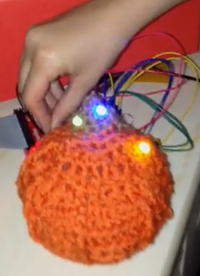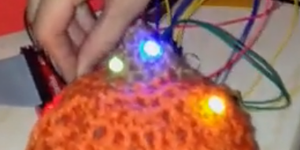Wire Some Trick-or-Treat or Light-up Fun with Scratch and Raspberry Pi
With the new Raspberry Pi Projects Kit from Science Buddies, students can explore a series of activities that combine creativity, electronics, and computer programming using Scratch—no prior experience required! For this middle school student, a homemade pumpkin was a perfect thing to light up with LEDs!

Laura, a 7th grade student in CA has an interest in electronics and creative and handmade projects. This summer, she used the Raspberry Pi Projects kit at home and explored an exciting series of hands-on challenges and activities that let her combine her interests. Like many students her age, Laura is a computer-savvy middle school student. She knows some HTML and CSS, she succeeded at the country fair with a 3D robotics modeling project, and she has some experience using Scratch, a popular drag-and-drop interface that makes it easy for students to get started with computer programming projects.
The Raspberry Pi Projects Kit gave her the opportunity to do some really cool, creative projects over the summer break, all while learning more about computer programming and increasing her electronics and circuit-building skills.
Creative Electronics
Laura says she was intrigued initially by the kit because she knew that the projects would let her see real-world results, like something lighting up. When asked if she thought of computer programming as a "creative" activity before working with the Raspberry Pi Projects Kit, Laura says she did "because you can create colorful and exciting things with computer programming." With the kit's guided activities, Laura discovered that in addition to the cool things you can program to happen "on" screen, you can connect programming to hands-on, real-world creative projects and objects, too. Emphasizing this link between connecting a computer program to a circuit that you wire and that is connected to a piece of art or an object makes working with the Raspberry Pi Projects Kit a unique and fun learning experience for students. These projects are not "just" about code on a screen. Instead, students are bridging what happens on the screen to a circuit they build as part of a creative project. Adding light-up effects to a drawing, in this scenario, is as "doable" as adding glitter or gluing on googly eyes.
Laura says she enjoys sewing more than drawing, so she adapted the Starry Night activity to add LEDs to a crocheted pumpkin her Mom made. Her adaptation of the project was a great way to experiment and to create something that she and her family can enjoy. (It's a perfect project for Halloween decorating!)
One Project at a Time
The series of eight projects used with the Raspberry Pi Projects Kit from the Science Buddies Store guide students in using Scratch to write short programs that work with a breadboard on which the student creates a circuit using various kinds of sensors to cause something to "happen" in response to real-world input. For example, students can turn household objects, like measuring cups, into a set of customized drums or combine LEDs with a piece of art so that it will light up when the light in a room dims. As a student works through the projects, the various challenges invite creativity and innovation, and the skills learned and practiced in these projects can then be extended and adapted to work with other projects of the student's own design.
Of the eight projects, Laura says she most enjoyed the Invader Alert! project. "It was my favorite because it sensed whenever my cat came into my room," she explains. After finishing the series, Laura combined the technology (and code) used in the Starry Night and Make Music in Your Kitchen projects to make her own variation. "I made a scene for night and day, and a light would come on when it was light or dark and so would a sound," says Laura. "When it was light, a meow sounded, and there was a light that was the Sun. When it was dark, a cricket sounded, and there was a light that was Polaris."
Laura integrated sensors from the kit to enable both the light-sensing and noise-making parts of her project. "The sounds happened whenever someone tapped the aluminum foil," says Laura. The project was a challenge and required Laura to synthesize and combine what she had learned, both in creating the circuit and in combining the code in Scratch. Laura shows off her project in the video below.
A Launchpad for Learning
As a result of working with the Raspberry Pi Projects Kit, Laura says she is now interested in learning more about computer programming, learning Python, and writing more sophisticated code that she can hook to her creative projects and circuits. She already has an idea for a program that will take a user's birth date, calculate how close it is to one number or another, and turn a light on based on the result!
This Halloween, we hope trick or treaters who visit Laura's house might catch a glimpse of a very special pumpkin decoration!
More Raspberry Pi at Science Buddies
To learn more about Raspberry Pi, computer programming, Scratch, and Science Buddies projects that use the Raspberry Pi Projects Kit, see the following resources:
- Creative Raspberry Pi Projects for Beginners
- New Raspberry Pi Projects Kit (book review)
- Do Even More with Your Raspberry Pi Projects Kit
- Light Up the Season with Computer Science Exploration
- Program Summer with Cool Computer Code
- Computer Programming Basics: An Hour of Code
- Playful Programming and Cool Code: From Tech User to Tech Creator
- Super Scratch Succeeds in Scratching the Surface of Code with Cartoon Fun (book review)
- A Trick of the Eye for Halloween (get creative with Scratch)
The Raspberry Pi Projects Kit was developed thanks to generous support from sponsors, including Symantec and the Best Buy Foundation.
Raspberry Pi is a trademark of the Raspberry Pi Foundation.
You Might Also Enjoy These Related Posts:
- Plastics and Earth Day - Science Projects
- Arduino Science Projects and Physical Computing
- 10+ Robotics Projects with the BlueBot Kit
- 5 STEM Activities with Marshmallow Peeps
- March Madness Basketball Science Projects: Sports Science Experiments
- Women in STEM! More than 60 Scientists and Engineers for Women's History Month
- Explore Artificial Intelligence and Machine Learning with Student AI Projects
- 10 Reasons to Do the Rubber Band Car Engineering Challenge










